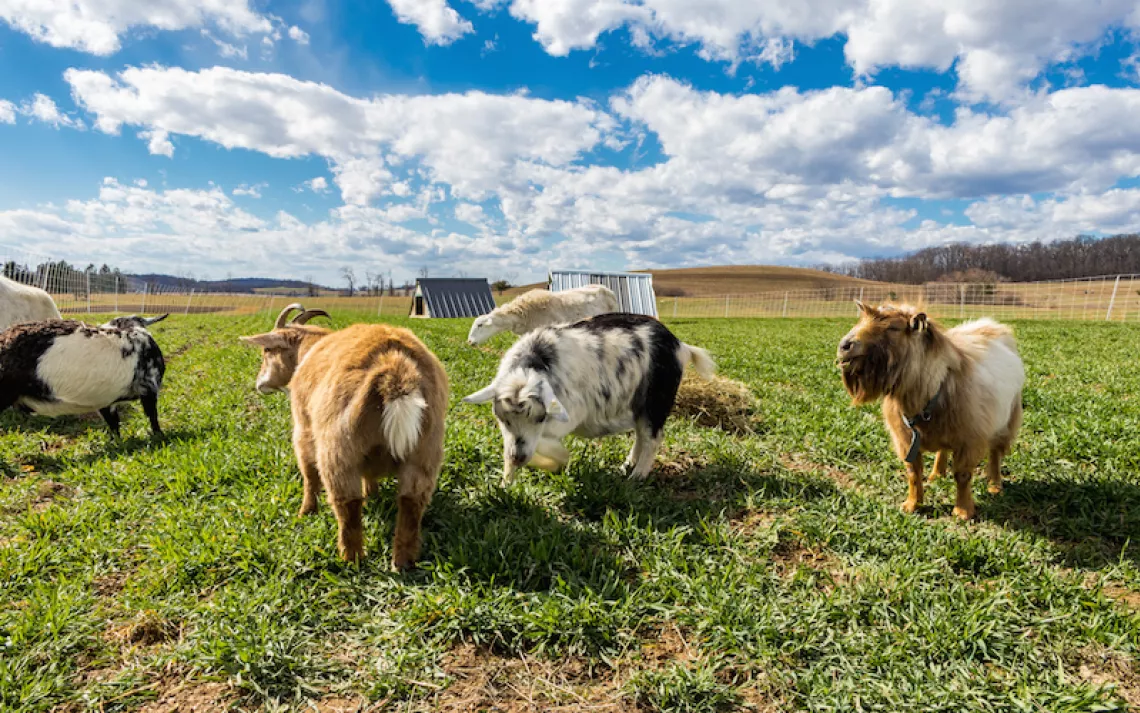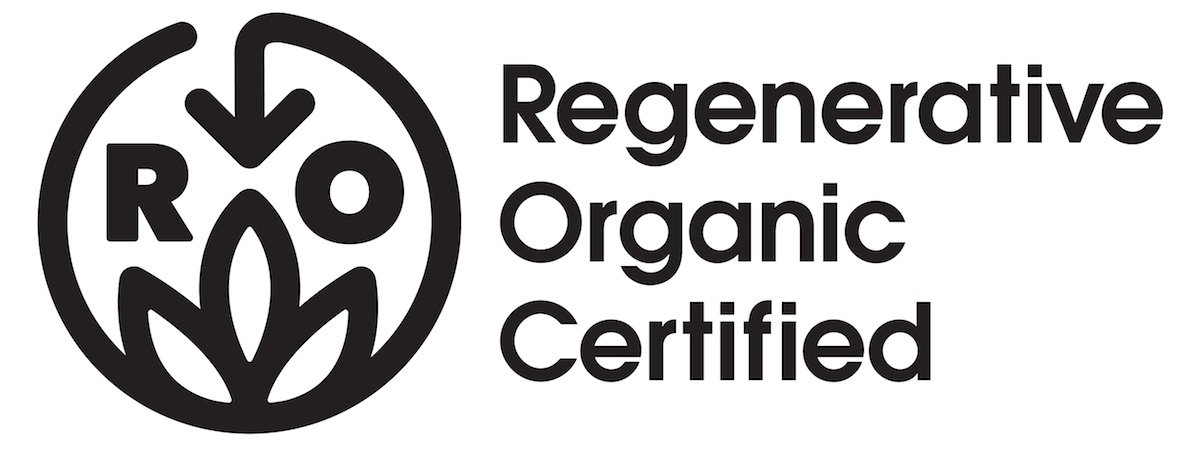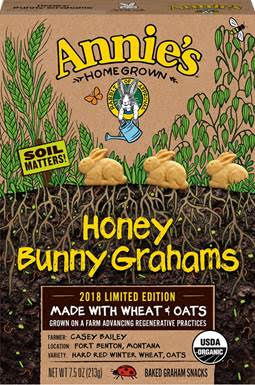“Beyond Organic” Food Labels Seek to Supplant the USDA Standard
What does Regenerative Organic Certification mean for producers and consumers?

Courtesy of the Rodale Institute
The word “sustainable” doesn’t pack much punch any longer. Whether through overuse or greenwashing, it seems to have joined the same ranks as “eco” and “natural,” terms that essentially mean everything and nothing at once. Employed as it so often is—to blithely extoll corporate greening efforts and lifestyle products—some feel the word runs the risk of obscuring more than it reveals. “We should not as a society want to sustain; we should strive to improve,” says Jeff Moyer, executive director of the Rodale Institute, a nonprofit that conducts and funds organic farming research. “Ask growers in the developing world—they’re not hoping to sustain their subsistence farms, but to improve their soil and yields.”
It was an effort to move beyond sustainability that inspired the Rodale Institute to partner with two like-minded companies—Patagonia and Dr. Bronner’s—to create a Regenerative Organic Alliance and introduce a new food product label designed to encourage and reward continuous improvement in agricultural practices: the Regenerative Organic Certification (ROC), which officially launched earlier this month at the Natural Products Expo West trade show in Anaheim, California.

ROC products will have to be made with ingredients from farms that use certified regenerative farming systems that aim to build healthy soil, boost biodiversity, and draw carbon from the atmosphere via methods like cover cropping and minimum tillage. The new label has farmers move up through a tiered system designed to incentivize constant improvement in practices. It’s not intended to undermine USDA Organic certification but rather to serve as an “add-on.” Agriculture products will only be eligible if they already have USDA certification or an international equivalent. After all, the players behind ROC are a large part of why the U.S. has its existing organic label.
J.I. Rodale founded his institute in 1947, and in so doing helped to popularize a holistic, whole-systems approach to farming in the United States. Rodale, his son Robert, and the rest of the institute eventually lobbied with farmers nationwide to get the federal government on board with organics. Their efforts ultimately helped bring about the Organic Foods Production Act of 1990, which authorized a USDA National Organic Program and set standards for the production, handling, and certification of organically grown agricultural products. “The organic industry has grown dramatically since the introduction of the USDA seal, but one of the things we lost in that adoption was the concept of continuous improvement,” Moyer says. “Whereas holistic organic principles are about continually improving the health of the soil and fair treatment of the people and animals who create the food, the federal organics program simply created a baseline that said, ‘Once you cross this line, you’re in the club.’ So it’s challenging to get new components incorporated within that standard—it’s not built for continuous improvement.”
You won’t find products bearing the new ROC label on shelves until 2019 or 2020 (the alliance first needs to run a pilot program and determine how it’ll handle inspection, certification, and auditing). The alliance—rather than the USDA—will oversee certification. On top of using certified holistic farming systems, ROC-minted farms will have to meet strict animal and human welfare standards; ROC will recognize existing standards including “Animal Welfare Approved,” “Certified Humane,” and “Fairtrade International.” The purported objective is to foster a standard across the global supply chain that supports greater food security while mitigating climate change.
Coincidentally, the ROC announcement came days before the USDA officially withdrew the Organic Livestock and Poultry Practices Rule, killing many protections for animals raised on organic farms. And a month before, a group of concerned “dirt first” organic farmers, dismayed by last November’s controversial federal ruling that food grown without soil via hydroponic, aeroponic, and aquaponic methods could be eligible for organic certification, soft-launched another new label: the Real Organic Project (ROP).
Similar to the ROC, the Real Organic Project was conceived with an eye toward greater integrity and transparency in labeling. Vermont farmer and ROP founder Dave Chapman describes it as a label that represents “real organic—with animal welfare rules and the prohibition of CAFOs and hydroponics in place.” He adds, “This is not exactly radical stuff, just the basics that seem to separate the sheep from the wolves, because right now, a lot of wolves are able to misrepresent their products and profit off the organic label.”
Like Chapman, many growers and consumers are concerned that the word “organic” is becoming diluted. Some point to the big agri-business farms that they say have successfully co-opted the word as evidence of the label’s erosion. Moyer says this may be why, over the past several years, some have started using the word “regenerative”—to the point he fears that it, too, risks the same semantic fate as “sustainable” and “organic.”
“It’s becoming a marketing word,” Moyer says, “and people want to make money off it, so we wanted to put a stake in the ground around the concept and definitively link the two words—organic and regenerative—in a way that really helps to improve the health of the soil and better manage animals in our food systems, and incorporate social justice. We wanted to move that energy in a positive direction and improve the system.”
Birgit Cameron, senior director of Patagonia Provisions, the arm of the outdoor clothing company that’s devoted to climate-friendly foodstuffs, describes the ROC label as the new “north star” for the organic community to work toward. “We’re not trying to degrade USDA Organic, but rather to build upon it and create one standard that encompasses the trinity of what we think is the right path forward—the building of organic matter and taking care of soil as a live ecosystem, and social and animal welfare—and create a gold stamp that really means something, and that helps consumers cut through the confusion,” she says. “With the state of our environment, this is the moment to run down this path as fast as we can. Patagonia wanted to not only take this journey, but to invite others to join us in this movement.”
Tickets to said journey, however, don’t necessarily come cheap. Some small- and medium-scale farmers worry that the marketplace’s glut of new certifications will make it even harder to compete with Big Ag. “New sets of uniform national organic standards will simply create additional options for industrializing organic food production,” says John Ikerd, professor emeritus of agricultural economics at the University of Missouri and the author of the 2008 book Small Farms Are Real Farms: Sustaining People Through Agriculture. “Once these large agri-food corporations gain positions of influence, they’ll attempt to eliminate competition by creating complex regulatory requirements that smaller producers cannot meet—or can’t meet as efficiently. This is nothing new.”
One organic farmer, inspector, and auditor who prefers to remain anonymous put its more plainly: “How elitist can we get with farming? [These new labels] present a real threat to a lot of us because they totally favor large industrial farms. This is adding clutter and confusion to an industry already saturated with labels, many of them ultimately meaningless, that sow consumer confusion and make it harder on the noncorporate organic farmer: There’s ‘Bee-Friendly’ and ‘Non-GMO’ and ‘Paleo-Friendly’ and ‘Food-Justice-Certified’—the list goes on and on. Certified Organic was supposed to account for all this stuff! So, on smaller farms people are really frustrated because there are serious costs associated with all of these—not just in application and inspection fees but also in record-keeping and the time that takes. Large agri-businesses can employ people who take care of all this as their full-time job, but for everyone else, it just takes the farmer out of the field and might even dissuade young farmers from pursuing organic.”
This farmer also pointed out that while “we pretty much all believe in everything the ROC label stands for on a personal level,” its multifaceted ideals will likely prove difficult for smaller farmers to put into practice. “Not only is it going to make the organic landscape more corporate than it already is, but some of this stuff isn’t going to line up the way the Regenerative Alliance wants it to,” this farmer told Sierra. “For example, to be Animal Welfare–Approved, you have to be willing to treat your animals if they’re sick. But in the organic world, a lot of people aren’t necessarily treating sick animals because the second you use antibiotics, you’re removed from the organics program. ROC people are going to have to marry a lot of different philosophies around slaughtering and other issues.”
While Ikerd describes ROC and ROP labels as “a step in the right direction,” he, too, fears they could result in a more stiflingly bureaucratic process. “I would prefer organic ‘add-on’ or ‘real organic’ programs that are defined, organized, monitored, and enforced at the local or bio-regional level, by co-operative organizations,” he says. “Because when you introduce additional large-scale rules and regulations, you benefit industrial agriculture more than the small local guys—the ones who tend to run operations much closer to the authentic notion of organic.”
Rodale’s Moyer insists that the ROC label is scale-neutral and designed to recognize the fact that small- and medium-size farms are the “backbone” of organic agriculture. “ROC was developed to avoid duplication of audits and certifications and accepts existing high-bar certifications to fulfill requirements around both the animal welfare and fairness for farmers and farmworkers. For soil health, the ROC accepts existing certifications as a baseline step, and farms can tailor additional regenerative requirements to their specific growing regions,” he says. “One reason we incorporated farmer worker fairness and fair trade requirements was to ensure that small farmers have living wages, long-term contracts, and safe and fair working conditions.”
A spokesperson for Patagonia adds that the companies that came together to create the standard were in fact primarily concerned about Big Ag companies taking over the food system. “The most exciting thing about ROC is that it would force the worst actors to compete on a level playing field by internalizing costs, forcing agribusiness to fundamentally change its practices.”
There’s also the matter of sufficiently explaining what “regenerative” means to ordinary consumers. Patagonia’s Cameron believes this will come down to the alliance ensuring all participating brands are on the same page in terms of the ROC’s language and raison d’être. “If the messaging is consistent, then we can all employ our own brands’ personality to educate our customers with our own personality.”
 It’s worth noting that some brands already moving to embrace regenerative ag are owned by massive food corporations. This spring, Annie’s Homegrown (a General Mills brand) is partnering with a holistic farm in Montana to make limited-edition versions of its Organic Mac & Cheese and Organic Bunny Grahams (pictured, right) using ingredients grown using regenerative farming practices. In an unorthodox marketing choice, they’ll be packaged in boxes awash in photos of soil. Brands including Annie’s Homegrown and Ben & Jerry’s (owned by European food conglomerate Unilever) are reportedly developing another global verification standard for food grown in a regenerative manner. No word yet as to whether Ben & Jerry’s will find clever ways to incorporate “soil” or “carbon sequestration” into flavor names.
It’s worth noting that some brands already moving to embrace regenerative ag are owned by massive food corporations. This spring, Annie’s Homegrown (a General Mills brand) is partnering with a holistic farm in Montana to make limited-edition versions of its Organic Mac & Cheese and Organic Bunny Grahams (pictured, right) using ingredients grown using regenerative farming practices. In an unorthodox marketing choice, they’ll be packaged in boxes awash in photos of soil. Brands including Annie’s Homegrown and Ben & Jerry’s (owned by European food conglomerate Unilever) are reportedly developing another global verification standard for food grown in a regenerative manner. No word yet as to whether Ben & Jerry’s will find clever ways to incorporate “soil” or “carbon sequestration” into flavor names.
The question of whether ROC and other new designations will indeed resonate with consumers or instead prove to be another asset to industrial agriculture remains to be seen. But Moyer and company seem right about at least one thing—dirt is indeed trending.
 The Magazine of The Sierra Club
The Magazine of The Sierra Club



